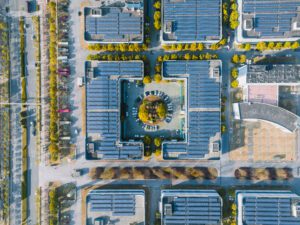
Steel is one of the world’s most vital engineering and construction materials for buildings, cars, trains, machinery, and more. Annual steel demand has tripled over the past 50 years and is expected to reach ~1.8 Megatonnes (Mt) in 2023.
However, iron ore mining and steel production processes generate high industrial carbon emissions. For example:
- 70% of global steel operations burn coal to feed blast furnaces, and steel plants emit up to 2.4 tons of CO2 for each ton of steel they produce.
- The steel industry alone is responsible for 9% of global emissions.
For these reasons, the industry faces pressure to decarbonize steel manufacturing processes. For example, steel consumers, like the automobile industry, have set aggressive Scope 3 emission targets (carbon emissions not produced by the company but associated with their supply/value chain). Therefore, to remain competitive and drive profitability, steel plants must respond to customers’ expectations to produce “green steel,” a low-emissions version of the traditional steel product.
Technological breakthroughs now allow green steel to be a reality
Fortunately, technological innovations make it possible for the industry to accelerate the pace of steel decarbonization.
Electrification of the steel industry, including the migration to Electric Arc Furnaces (EAF) and Direct Reduced Iron (DRI) processes, reduces CO2 emissions, enabling a transition to electricity and hydrogen. Plants that produce green steel, for which clients are now willing to pay a premium, use hydrogen in the DRI processes, Electric Arc Furnaces to melt steel, and power their operations using renewable energies. Steel companies in Western Europe are investing billions in enabling their plants to produce green steel.
As steel companies worldwide upgrade their facilities, the “process OEMs” (pOEMs) design these facilities, the technology manufacturers who equip them, and their end users play a critical role in providing low-carbon solutions. For example, Tenova, a worldwide partner for sustainable, innovative, and reliable solutions in the metals and the mining industries that works closely with Schneider Electric™ is leading the way in designing Direct Reduction systems fueled with hydrogen that can accommodate mixed fuel feeder stocks, perform carbon capture, and produce high-grade iron pellets feeding downstream electrical furnaces. Their technology enables more from 50% to 90% reduction in CO2 emissions compared to traditional approaches.
Electrification and digitization of operations lower steel carbon emissions
With new-generation steel plants running mainly on electricity, either through electric furnaces or using electricity for hydrogen manufacturing, electrical energy now represents 30-40% of production costs. Therefore, to reduce OpEx, corporate stakeholders must ensure the efficient use of electricity and alternative sourcing within their plants.
Wide and unified domains of expertise, including power and steel process, coupled with technology, exist today to enable electrification and digitization that can improve sustainability. Below are three ways process control technologies can contribute to green steel production:
- Digital twin – Cloud-based virtual models of a plant allow engineers to test control logic through detailed graphics in a virtual process analysis scenario. Digital twins help minimize potential design errors and streamline machine build processes to lower energy consumption and CO2 emissions. AVEVA and ETAP offer digital twin software solutions for plant mechanical design, automation, and electrical systems. This allows engineers to pinpoint where efficiency gains can be made and how downtime can be avoided. Such tools also help provide maintenance teams with more efficient training and troubleshooting options.
In addition, predictive maintenance models leveraging advanced analytics and machine learning can help improve plant resilience by flagging potential problems before they result in unanticipated downtime. They also provide recommendations on problem resolution. This model-based approach enables plant-wide optimization of energy and automation systems that is not achievable through more conventional control methods.
Operational visibility is also enhanced through dashboards and charts highlighting data from the equipment asset level up to the process unit, plant area, plant site, and enterprise levels. This enables operators, managers, and executives to see how their production and energy decisions can significantly improve profitability.
The predictive simulation capability is unlocked by connecting ETAP Digital Twin to field real-time data such as meter measurements or switch status. Operation and maintenance teams have a great asset available to better plan and bring peace of mind to their daily activities. This allows them to test and secure any network sequences of operations before implementing them on the field, thus avoiding unexpected plant downtime.
- Power and process convergence – Converged power and process architectures can use big data analytical engines to improve process performance and lower energy consumption through rapid and more accurate decision-making. Mathematical models predict the optimum mix of electricity, hydrogen, or alternative fuel usage to minimize production costs.
- Microgrids – As renewable energy emerges as a core contributor to green steel production, optimizing and managing energy use across various conditions and power sources becomes critical. Cloud-based microgrid management solutions provide a Human Machine Interface (HMI) for site managers, process the various demand/response requests, optimize output decisions based on energy time of use (TOU) tariff rates and weather forecast predictions, and factor in user consumption constraints.
With intuitive user interfaces, operators who use tools like EcoStruxure Microgrid Advisor are not required to be technically astute energy experts. The ability to tightly control energy use helps decrease energy bills, minimize CO2 footprint, and provide operational flexibility.
For more information
To learn more about accelerating carbon emissions reductions and reducing energy costs in steel manufacturing, watch this joint live session by Tenova, AVEVA, and Schneider Electric now.



